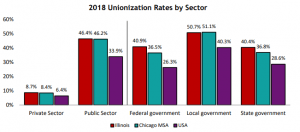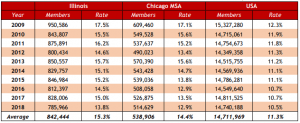For Immediate Release: September 2 2019
Contact: Frank Manzo IV, 708-375-1002, fmanzo@illinoisepi.org
Chicago: On Labor Day 2019, researchers from the Illinois Economic Policy Institute, University of Illinois at Urbana-Champaign, and University of California, Irvine released the sixth annual State of the Unions report for Illinois. The study finds that unions play an important role in Illinois’ economy communities, despite declining union membership over the past decade.
Read the entire report, The State of the Unions 2019: A Profile of Unionization in Chicago, in Illinois, and in the United States, here.
Since 2009, Illinois’ union membership rate has declined by 2 percentage points. After a one-year uptick, Illinois’ unionization declined from 15.0% in 2017 to 13.8% in 2018. Unionization decreased in the Chicago metropolitan area by about 12,000 members over the year.


Despite declines in union membership, the report concludes that labor unions boost worker incomes by lifting hourly wages by an average of 11%. In addition, the authors find that African Americans, military veterans, and rural workers are disproportionately more likely to be union members in Illinois.
“Unions raise wages for everyone, but especially for low-income and middle-class workers,” said Frank Manzo IV, Policy Director of the Illinois Economic Policy Institute. “Unions reduce inequality, provide family-supporting careers for our nation’s heroes, and foster a strong middle class in communities across Illinois.”


